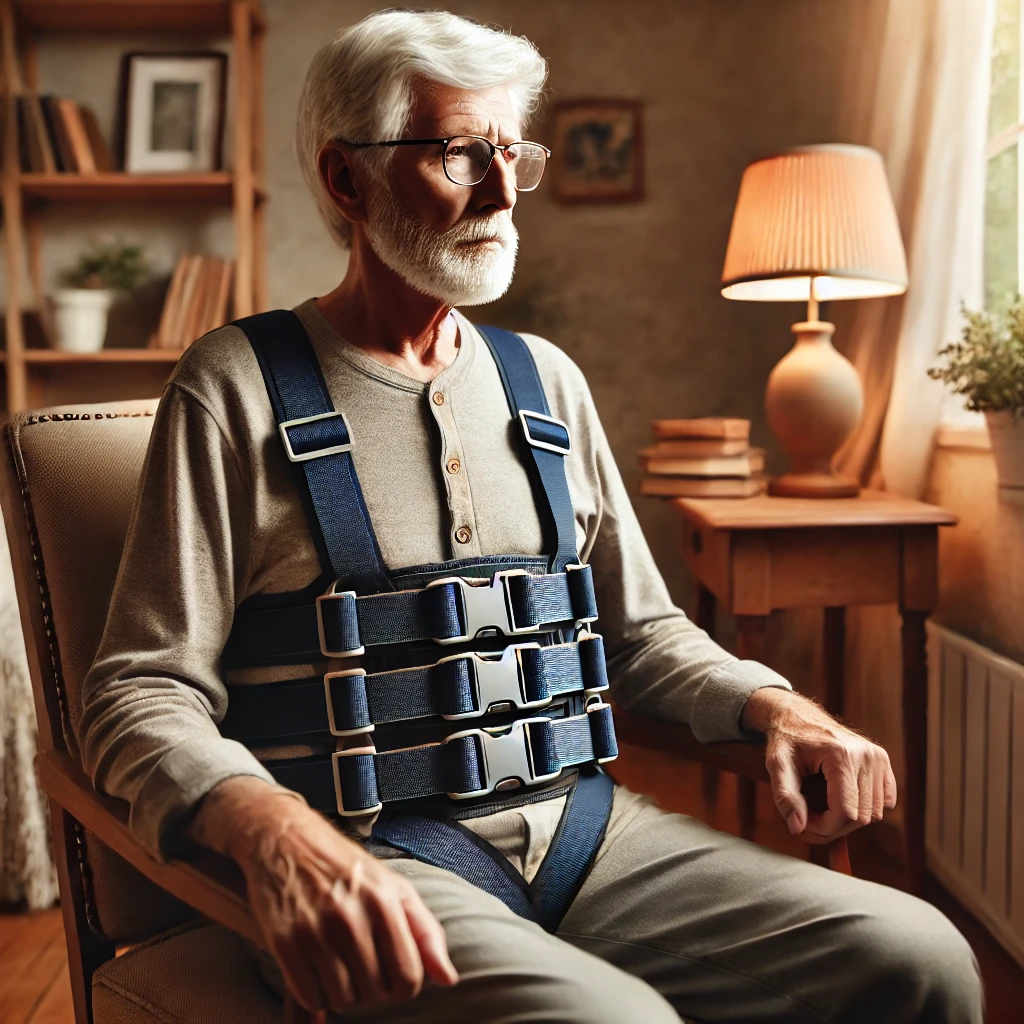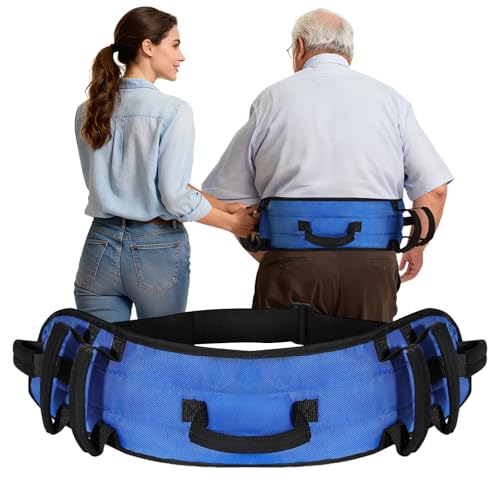Best Transfer Belts for Seniors [With 7 Handles]
As an Amazon Associate, I earn from qualifying purchase.
Have you ever tried helping a senior move from one place to another and found it difficult? I know how challenging it can be. That’s where transfer belts with handles come in handy. They make things easier and safer for both you and your loved one. With seven handles, these belts give you better control when helping someone stand or sit. Let me share some of the best transfer belts with you.
Here Are The Best Gait Belt Transfer Belts For Seniors With 7 Handles [For Waist]
1. Leetye Mei Gait Belts Transfer Belt for Seniors with 7 Handles
The Leetye Mei Gait Belt with seven handles is designed with practicality and safety in mind, particularly for aiding seniors during transfers. The standout feature is the seven handles, offering versatile grip options that make it easier to provide stable support. Whether assisting with movements from a bed, chair, or wheelchair, the handles allow for a firm, reliable hold. The belts are built from durable, high-quality materials, providing long-lasting performance even with frequent washing. Additionally, the fabric is soft to the touch, minimizing any discomfort. Its adjustable design ensures a secure, customized fit, and the contrasting colors add a layer of convenience for quick identification.
Pros:
- Multiple handles offer excellent support during transfers.
- Durable and easy to clean material.
- Adjustable for a secure fit.
Cons:
- Might be too large for smaller individuals.
- Handles can feel bulky at times.
2. Rhino Valley Gait Belt Transfer Belt
The Rhino Valley Gait Belt Transfer Belt is a practical tool designed to assist in transferring and stabilizing individuals with mobility challenges. Its seven handles, placed around the belt, offer multiple grip points, making it easier to guide and support from different angles. This feature is particularly useful when multiple caregivers are needed. However, while the belt’s fastener system snaps into place securely, adjusting the belt for a snug fit on smaller waists can be cumbersome due to its “one size” design. A range of sizes would likely improve the overall functionality and fit.
Pros:
- Multiple handles provide better support and control.
- Secure fastener ensures safety during use.
- Handles allow for assistance from several angles.
Cons:
- “One size” may be too large for some individuals.
- Difficult to adjust and secure in place.
- No size variations available.
3. Reaqer Gait Belts Transfer Gait Belt
The Reaqer Gait Transfer Belt is a practical choice for safely assisting individuals with mobility challenges. It features seven handles, making it easier for caregivers to securely hold and support a person during transfers or walking. The two leg straps add extra stability by preventing the belt from sliding upwards, which can help protect against injuries. The light blue color with foam-padded handles also adds a bit of comfort during use. Moreover, the belt’s mesh-covered surface promotes breathability, which is useful during extended use. Overall, this belt offers a good balance of safety and comfort in a lightweight design.
Pros:
- Includes seven foam-padded handles for better control.
- Added leg straps enhance stability.
- Breathable mesh material for added comfort.
Cons:
- May take time to adjust properly.
- Not suitable for extremely large individuals.
- Requires two hands to operate effectively.
4. Supregear Gait Belt
The Supregear Gait Belt with 7 handles is a well-designed transfer and walking aid, ideal for assisting those with mobility challenges. With multiple handles, it offers caregivers secure grips, enhancing control and safety during transfers. The anti-slip design adds extra stability, while the quick-release snap buckle simplifies the process of putting it on or removing it. The belt’s sturdy construction ensures durability and reliability, making it suitable for daily use in home care settings. Additionally, its adjustable size makes it versatile enough to fit different body types comfortably.
Pros:
- Multiple handles provide better grip and control.
- Quick-release buckle for easy use.
- Sturdy and durable construction.
Cons:
- May not be comfortable for extended wear.
- Bulkier design compared to simpler belts.
- Limited color or design options.
Buyer’s Guide – Choosing the Best Transfer Belts for Seniors [With 7 Handles]
When it comes to helping seniors move safely and comfortably, using a transfer belt with handles can make all the difference. These belts are designed to assist caregivers in moving or transferring individuals from one place to another with ease, while also ensuring the senior’s safety. But not all transfer belts are the same, especially those with 7 handles. Here are five key factors to consider before choosing the best one.
1. Comfort and Fit

A transfer belt should be comfortable for the person wearing it. It’s essential to choose one that fits snugly but not too tight around the waist. Many transfer belts come in adjustable sizes, so make sure you select one that can be easily adjusted to fit a variety of waist sizes. Additionally, the material of the belt matters. A padded belt might offer more comfort, especially for those who wear it for extended periods.
2. Durability
When you’re looking for a transfer belt, it’s important to consider its durability. Since you’ll be using it regularly, it needs to be made from strong, high-quality materials that won’t tear or wear out easily. Check for belts made from reinforced fabric or nylon, as these are often more long-lasting and can withstand repeated use without breaking or losing their grip.
3. Number of Handles

One major advantage of transfer belts with 7 handles is the added stability they provide. These handles allow caregivers to have a better grip and more control while helping seniors move. This makes it easier to lift, rotate, or adjust the position of the senior without putting too much strain on the caregiver’s body. So, when considering a transfer belt, opt for one with multiple handles, as this can make the whole process smoother and safer.
4. Ease of Use
The belt should be easy to put on and take off. It’s important to look for one with a simple buckle or Velcro closure that secures firmly around the waist. Some belts come with quick-release buckles, which allow for fast removal in case of emergencies. You also want to make sure that the belt is easy to adjust while it’s being worn, so you can ensure a snug and comfortable fit every time.
5. Weight Capacity

Finally, it’s crucial to check the weight capacity of the transfer belt. Every belt comes with a recommended weight limit, and it’s essential that the belt you choose can safely support the senior. Choosing a belt that can handle a higher weight capacity will also ensure that it can be used for a wide range of individuals, making it more versatile.
FAQs
What is so special about Transfer Belts for the waist?
Transfer belts for the waist are designed to give caregivers more control and stability while assisting seniors in moving or transferring from one place to another. They reduce the risk of falls and make the process smoother, both for the senior and the caregiver.
How do you wear a transfer belt? Can it be worn on your own?
To wear a transfer belt, simply wrap it around the senior’s waist and secure it using the buckle or Velcro closure. It should fit snugly but comfortably. While it’s possible to wear it on your own, a caregiver should always assist in securing the belt to ensure it’s properly fitted and safe.
What are other types of transfer belts?
There are several types of transfer belts, including those with fewer handles, padded belts for added comfort, and belts with quick-release buckles. Some belts are designed for specific uses, such as standing or sitting transfers, while others are more versatile and can be used for various movements.
How is a Transfer Belt for the waist different from other types?
A transfer belt for the waist is specifically designed to be worn around the waist to give caregivers better control and leverage. Other types of belts, such as shoulder or torso belts, may provide support in different areas of the body but might not offer the same level of stability during transfers.
Why 7 handles?
Transfer belts with 7 handles are designed to give caregivers multiple gripping points. This makes it easier to assist seniors from various angles, offering better control and stability during the transfer. More handles mean more flexibility for both the senior and the caregiver, especially in situations that require careful movement.
Are transfer belts machine-washable?
Yes, many transfer belts are machine-washable. However, it’s important to check the care instructions that come with the belt. Some belts may need to be hand-washed or air-dried to ensure they last longer.
Can a transfer belt be used for lifting?
Transfer belts are primarily used for assisting in transfers, such as moving from a bed to a wheelchair. They are not designed for lifting a person off the ground or carrying them. Always use proper lifting equipment for heavier tasks to avoid injury.
Can you use a transfer belt on someone with fragile skin?
If the person has fragile skin, it’s important to use a padded transfer belt to avoid discomfort or skin damage. Always check the belt’s fit to ensure it’s not too tight and monitor the senior’s skin for any signs of irritation.
Thanks for reading this guide! Hopefully, it was helpful in your search for the best transfer belt. Don’t forget to check out other articles for more caregiving tips.





